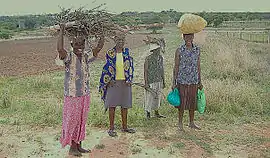Maranda, Zimbabwe
Maranda, locally known as "No. 1", is a small business center on the northern edge of Mwenezi (District), Zimbabwe. It is the home town of Dr. Love (Paul Matavire), the former popular musician and Nikita Mangena, Zimbabwe People's Revolutionary Army military leader during the Second Chimurenga war. It is a center of trade in the district, with people coming to sell their cattle in week-long trade fairs. The centre has a clinic and government agriculture and water offices.

Geography
Maranda is surrounded by granite mountains such as Bangwe, Rasha and Nemande. These are the source of the Mushawe River, which flows through the business centre and supplies the centre with water. The water is abstracted from the alluvial aquifer below the Mushawe River, and is generally available year-round[1]
Rainfall is erratic and the vegetation is savanna dominated by grasses and Mopane trees. In the days of old, the villagers used to plant millet and sorghum but these days most villagers plant maize on account of the high yields associated with it.

Market
No. 1 is a popular destination in the district, especially during the week-long market days when residents from the surrounding villagers descend on the business center to sell their merchandise. Most people sell their cattle, while other just come to the market to dance to sungura music from singers like Alick Macheso and Khiama Boys.
Government & politics
Maranda is in ward 9, in the newly created House of Assembly seat of Mwenezi West.
References
- Love, D. de Hamer, W., Owen, R.J.S., Booij, M.J., Uhlenbrook, S., Hoekstra, A. and van der Zaag, P. 2007. Case studies of groundwater – surface water interactions and scale relationships in small alluvial aquifers. In: Abstract volume, 8th WaterNet/WARFSA/GWP-SA Symposium, Lusaka, Zambia, November 2007, p21.